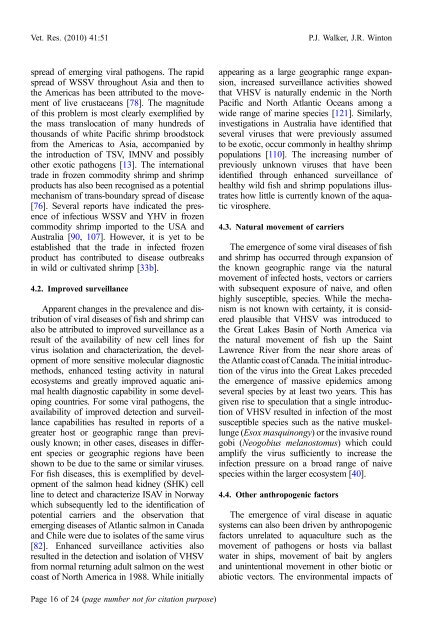Emerging viral diseases of fish and shrimp - Watershed Watch ...
Emerging viral diseases of fish and shrimp - Watershed Watch ...
Emerging viral diseases of fish and shrimp - Watershed Watch ...
You also want an ePaper? Increase the reach of your titles
YUMPU automatically turns print PDFs into web optimized ePapers that Google loves.
Vet. Res. (2010) 41:51<br />
P.J. Walker, J.R. Winton<br />
spread <strong>of</strong> emerging <strong>viral</strong> pathogens. The rapid<br />
spread <strong>of</strong> WSSV throughout Asia <strong>and</strong> then to<br />
the Americas has been attributed to the movement<br />
<strong>of</strong> live crustaceans [78]. The magnitude<br />
<strong>of</strong> this problem is most clearly exemplified by<br />
the mass translocation <strong>of</strong> many hundreds <strong>of</strong><br />
thous<strong>and</strong>s <strong>of</strong> white Pacific <strong>shrimp</strong> broodstock<br />
from the Americas to Asia, accompanied by<br />
the introduction <strong>of</strong> TSV, IMNV <strong>and</strong> possibly<br />
other exotic pathogens [13]. The international<br />
trade in frozen commodity <strong>shrimp</strong> <strong>and</strong> <strong>shrimp</strong><br />
products has also been recognised as a potential<br />
mechanism <strong>of</strong> trans-boundary spread <strong>of</strong> disease<br />
[76]. Several reports have indicated the presence<br />
<strong>of</strong> infectious WSSV <strong>and</strong> YHV in frozen<br />
commodity <strong>shrimp</strong> imported to the USA <strong>and</strong><br />
Australia [90, 107]. However, it is yet to be<br />
established that the trade in infected frozen<br />
product has contributed to disease outbreaks<br />
in wild or cultivated <strong>shrimp</strong> [33b].<br />
4.2. Improved surveillance<br />
Apparent changes in the prevalence <strong>and</strong> distribution<br />
<strong>of</strong> <strong>viral</strong> <strong>diseases</strong> <strong>of</strong> <strong>fish</strong> <strong>and</strong> <strong>shrimp</strong> can<br />
also be attributed to improved surveillance as a<br />
result <strong>of</strong> the availability <strong>of</strong> new cell lines for<br />
virus isolation <strong>and</strong> characterization, the development<br />
<strong>of</strong> more sensitive molecular diagnostic<br />
methods, enhanced testing activity in natural<br />
ecosystems <strong>and</strong> greatly improved aquatic animal<br />
health diagnostic capability in some developing<br />
countries. For some <strong>viral</strong> pathogens, the<br />
availability <strong>of</strong> improved detection <strong>and</strong> surveillance<br />
capabilities has resulted in reports <strong>of</strong> a<br />
greater host or geographic range than previously<br />
known; in other cases, <strong>diseases</strong> in different<br />
species or geographic regions have been<br />
shown to be due to the same or similar viruses.<br />
For <strong>fish</strong> <strong>diseases</strong>, this is exemplified by development<br />
<strong>of</strong> the salmon head kidney (SHK) cell<br />
line to detect <strong>and</strong> characterize ISAV in Norway<br />
which subsequently led to the identification <strong>of</strong><br />
potential carriers <strong>and</strong> the observation that<br />
emerging <strong>diseases</strong> <strong>of</strong> Atlantic salmon in Canada<br />
<strong>and</strong> Chile were due to isolates <strong>of</strong> the same virus<br />
[82]. Enhanced surveillance activities also<br />
resulted in the detection <strong>and</strong> isolation <strong>of</strong> VHSV<br />
from normal returning adult salmon on the west<br />
coast <strong>of</strong> North America in 1988. While initially<br />
appearing as a large geographic range expansion,<br />
increased surveillance activities showed<br />
that VHSV is naturally endemic in the North<br />
Pacific <strong>and</strong> North Atlantic Oceans among a<br />
wide range <strong>of</strong> marine species [121]. Similarly,<br />
investigations in Australia have identified that<br />
several viruses that were previously assumed<br />
to be exotic, occur commonly in healthy <strong>shrimp</strong><br />
populations [110]. The increasing number <strong>of</strong><br />
previously unknown viruses that have been<br />
identified through enhanced surveillance <strong>of</strong><br />
healthy wild <strong>fish</strong> <strong>and</strong> <strong>shrimp</strong> populations illustrates<br />
how little is currently known <strong>of</strong> the aquatic<br />
virosphere.<br />
4.3. Natural movement <strong>of</strong> carriers<br />
The emergence <strong>of</strong> some <strong>viral</strong> <strong>diseases</strong> <strong>of</strong> <strong>fish</strong><br />
<strong>and</strong> <strong>shrimp</strong> has occurred through expansion <strong>of</strong><br />
the known geographic range via the natural<br />
movement <strong>of</strong> infected hosts, vectors or carriers<br />
with subsequent exposure <strong>of</strong> naive, <strong>and</strong> <strong>of</strong>ten<br />
highly susceptible, species. While the mechanism<br />
is not known with certainty, it is considered<br />
plausible that VHSV was introduced to<br />
the Great Lakes Basin <strong>of</strong> North America via<br />
the natural movement <strong>of</strong> <strong>fish</strong> up the Saint<br />
Lawrence River from the near shore areas <strong>of</strong><br />
the Atlantic coast <strong>of</strong> Canada. The initial introduction<br />
<strong>of</strong> the virus into the Great Lakes preceded<br />
the emergence <strong>of</strong> massive epidemics among<br />
several species by at least two years. This has<br />
given rise to speculation that a single introduction<br />
<strong>of</strong> VHSV resulted in infection <strong>of</strong> the most<br />
susceptible species such as the native muskellunge<br />
(Esox masquinongy) or the invasive round<br />
gobi (Neogobius melanostomus) which could<br />
amplify the virus sufficiently to increase the<br />
infection pressure on a broad range <strong>of</strong> naive<br />
species within the larger ecosystem [40].<br />
4.4. Other anthropogenic factors<br />
The emergence <strong>of</strong> <strong>viral</strong> disease in aquatic<br />
systems can also been driven by anthropogenic<br />
factors unrelated to aquaculture such as the<br />
movement <strong>of</strong> pathogens or hosts via ballast<br />
waterinships,movement<strong>of</strong>baitbyanglers<br />
<strong>and</strong> unintentional movement in other biotic or<br />
abiotic vectors. The environmental impacts <strong>of</strong><br />
Page 16 <strong>of</strong> 24 (page number not for citation purpose)
















